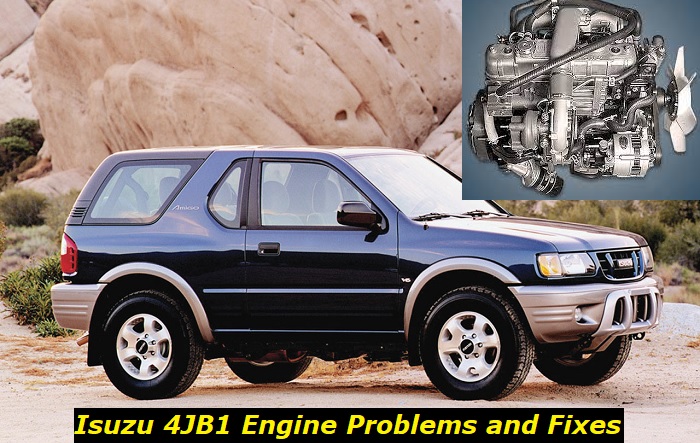Isuzu engines have always had quite a high reputation. The 4JB1 engine is special. It was the great continuation of the legendary diesel engine series and really became a legendary machine. There were several modifications of the 4JB1 model but everything in this article is applicable to all of them.
Today, I will tell you more about the common problems with the 4JB1 engine by Isuzu. Also, I will cover its advantages and some flaws you should know about. Although this is not the most popular engine in the US or in the world, it certainly deserves your attention. The machine offers a lot of cool features and genius solutions.

Here's what exactly I will tell you today:
- What should you know about the 4JB1 engine offered by Isuzu?
- How many miles will this engine survive?
- What are the common problems with the 4JB1 engine?
- How can you prolong the life of this machine?
Let's get started!
Key features of the 4JB1 engine in Isuzu trucks
So, this engine was first introduced in 1988 in Japan and was manufactured for a decade - up to 1998. There were mainly two versions of this engine - the one without the turbo and the one with the turbocharger. But they actually had a lot of differences. The engine was used in many Isuzu models such as Faster, Trooper, MU, and Wizard. Also, the same engine with some modifications was used in the Opel Frontera SUV in Europe.
Interestingly, this engine became the base for a lot of industrial diesel engines development. Even now, dozens of Chinese car manufacturers and industrial equipment manufacturers, use their copies of this engine in their vehicles and equipment. This proves that the technology was unbelievably reliable and overall great.
Here's what you should know about this engine:
- the 4JB1 engine has 2.8 liters of displacement, this is a 4-cylinder machine with an over-head valve system;
- the version without the turbocharger offered just 90 horsepower while the turbocharged 4JB1 had up to 115 horsepower;
- the important advantage is the torque that could be up to 174 lb-ft without any modifications and addons;
- the block and the head were made of cast iron, there were only 2 valves per cylinder, and basically nothing that could go wrong;
- the non-turbo version had the gear-powered timing system while the turbo 4JB1 got the timing belt for this;
- also, the non-turbo version had hydraulic lifters while the turbocharged engine required manual valve adjustment;
- it was a surprisingly economical diesel engine with about 23.5 MPG in the city and 33.5 MPG on the highway in the Isuzu MU.
Wonderful construction has just nothing to worry about. The non-turbo version is really rare and is mainly used in industry while the majority of vehicles got the turbocharged diesel engine. Actually, the turbo engine has much more potential problems that you should know about before you get one of the old Isuzu vehicles powered with this engine.
But even with the turbo and all other equipment, this engine can live much more than almost any modern engine. You may ask why then we don't have these wonderful machines under the hoods of modern vehicles in the US? Well, they are not really eco-friendly. Back in 1998, they were really hard to fit into the emission restrictions. Now, it's completely impossible.
How many miles will the 4JB1 engine live?
This is an extremely durable engine that offers wonderful quality and longevity. You can't even say for sure that at a certain mileage mark, this engine should die. If it's not abused and is maintained perfectly, it can last more than you and me.
On average, these Isuzu diesel engines can live about 270,000 to 300,000 miles. Non-turbo versions live longer while the turbocharged models may have a slightly shorter lifespan due to several common problems.
I've shown the average lifespan and it doesn't mean that when your MU hits 300K miles, it should immediately die. With good maintenance, these engines are good to go much more than that. I've seen an MU powered by the 4JB1 engine with over 500,000 miles on the dash. And the owner said that the odometer dies two years ago. Fantastic!
Of course, these machines are not new and bad things may happen with them now and then. Unfortunately, they are not flawless and they can still get broken and require a lot of investment to get them back on the road.
What are the common problems with the 4JB1 engine?
Even though these engines are thought to be not problematic at all, they have some issues that may attack the machine from time to time. Given that finding good parts for this engine is a big challenge, you may eventually find it fatally damaged and find no ways to restore it. The age of this engine is one of the problems and it can be really bad, in some cases.
Also, here are some of the common technical issues people complain a lot about in forums and blogs:
1. Zexel direct injection system
The system is perfect and it lasts very long. But when something in Zexel injection goes wrong, it will cost you a fortune to repair. The engineering is pretty simple and any good mechanic will easily fix it. But finding parts for Zexel injection is something you never want to deal with.
Also, some parts are only available in other countries and it will take weeks or even months to have them delivered to the US. So, you better try and save this injection system clean and healthy as long as you can. Otherwise, your car may sit for a while when the injection system fails and needs repairs.
2. Belt in turbo engines
While non-turbocharged engines have geared timing systems and they never fail, the turbo version has a belt-driven timing system. The belt is not eternal and you shouldn't forget to replace it at least once every 6 years or after 40-50 thousand miles. If you fail to do this, the belt may break or stretch and jump. This may not cause a very bad effect on valves, but some unpleasant consequences are guaranteed.
Fortunately, the timing belt kit is pretty easy to install and many owners do that on their own.
3. Oil pump issues
Now, when all these engines are very old and mostly have a lot of miles on them, another common issue became clear. This is the oil pump gear issue. Quite often, the gear on the oil pump is destroyed and the pump just stops pumping the oil in the engine. This may cause severe issues like a lack of lubrication in the turbocharger and in the head.
If noticed promptly, this problem will not destroy the engine. Just replacing the pump will fix the issue. But if the problem is ignored, the engine may be completely broken after several miles.
4. Valve adjustment issues
The turbo engines have no hydraulic lifters and you will need to adjust the valves manually. This is not a super complicated task for a mechanic, but you will need to go to the shop once every 25,000 miles, according to Isuzu regulations. That's quite often and the adjustment will not cost you just a couple of dollars - this is an expensive task, anyway.
Surprisingly, the non-turbo versions of this diesel engine have hydraulic lifters and you won't need to adjust the valves in them.
Can you prolong the life of the 4JB1 engine?
Of course, your maintenance and driving style will affect the overall lifespan of this engine. You may kill it for 100K miles if you only go off-roading and never care about maintenance. Or you may drive it 500,000 miles and be quite happy with the cost of driving.
Here are several things you may want to do:
- change oil and filter more often than you usually do - 5-6 thousand miles is a good interval for this engine;
- have the valves adjusted at least once every 25,000 miles;
- change the timing belt once every 40-50 thousand miles or up to 5 years;
- use only high-quality and clean diesel fuel to avoid issues with the injection system;
- if you get your Isuzu off the road often, change air filters with every oil change;
- avoid abusing this engine - it loves working at relatively low RPM.
Actually, this machine can work in different conditions and still be OK. So, you won't need to worry much about its durability or quality. The engine is almost eternal if driven properly and maintained regularly.
Final thoughts
If you still own the Isuzu (or any other vehicle) with the 4JB1 engine under its hood, you should know that the engine is super durable. It requires special attention in terms of fuel injection system operation and valves, but these are cheap maintenance procedures that will not cost you a fortune.
If maintained well, this engine is capable of going over 300,000 miles even if you are off-roading quite often.
About the authors
The CarAraC research team is composed of seasoned auto mechanics and automotive industry professionals, including individuals with advanced degrees and certifications in their field. Our team members boast prestigious credentials, reflecting their extensive knowledge and skills. These qualifications include: IMI: Institute of the Motor Industry, ASE-Certified Master Automobile Technicians; Coventry University, Graduate of MA in Automotive Journalism; Politecnico di Torino, Italy, MS Automotive Engineering; Ss. Cyril and Methodius University in Skopje, Mechanical University in Skopje; TOC Automotive College; DHA Suffa University, Department of Mechanical Engineering






Add comment